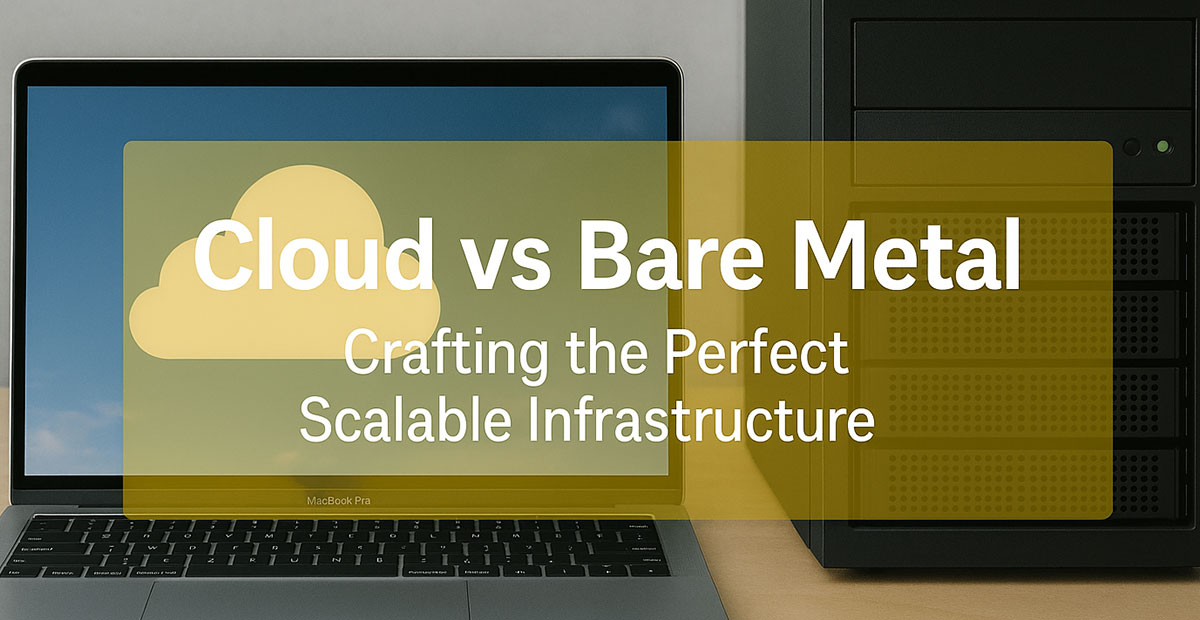No products in the cart.
 Smart Scaling in a Hybrid Era
Smart Scaling in a Hybrid Era
As digital demand soars, scalability has become critical—not optional. As a result, businesses must move beyond monolithic systems and instead build architectures that seamlessly adapt to growth, sudden traffic spikes, and evolving workloads. In response to these demands, the answer lies in a hybrid approach—one that effectively merges the flexibility of cloud with the raw power of bare metal servers.
What Is Scalable Architecture—And Why It Matters
In essence, an effective scalable architecture adapts to shifting demand without sacrificing system reliability or resource efficiency. Specifically, key benefits include:
- Performance: Delivers consistent user experiences under high load
- Resilience: Fault-tolerant, multi-zone setups reduce downtime
- Cost-Efficiency: Aligns resource usage with business needs
- Flexibility: Adapts to unpredictable traffic or workloads
However, traditional infrastructure struggles with these demands, especially tightly coupled legacy systems. Therefore, shifting to a modular, scalable architecture is essential for sustainable growth.
Cloud vs Bare Metal: Choosing the Right Fit
Both cloud and bare metal offer unique strengths:
| Feature | Cloud | Bare Metal |
| Performance | Virtualized, variable | High, consistent |
| Cost | Pay-per-use, costly at scale | Lower at full utilization |
| Control | Limited customization | Full hardware control |
| Deployment | Instant provisioning | Slower setup |
| Best For | Dev/test, APIs, microservices | Databases, AI/ML, intensive computing |
Consequently, hybrid environments offer the best of both worlds—speed from cloud-native platforms and power from bare metal—thereby allowing dynamic workload placement based on specific needs.
Workload Placement Strategies
To maximize efficiency, align your infrastructure choice—cloud or bare metal—with the performance, scalability, and control requirements of each workload.
✅ Use Cloud When:
- Running stateless or distributed apps
- Scaling quickly or frequently
- Needing managed services (e.g., DBaaS, monitoring)
✅ Use Bare Metal When:
- Hosting resource-heavy, low-latency apps
- Performing real-time analytics or GPU workloads
- Requiring OS-level and hardware control
As a result, matching each workload to its ideal environment significantly boosts performance and efficiency.
Architectural Design for Hybrid Success
To build a truly scalable hybrid architecture, focus on modularity and independence:
- Microservices: Decouple components to scale independently
- Containers: Package apps for portability (e.g., Docker)
- Orchestration: Automate scaling with Kubernetes
- Multi-zone Deployment: Ensure uptime with geographic distribution
- Loose Coupling: Minimize interdependencies to enhance resilience
These principles create a foundation that’s scalable, portable, and cloud-agnostic.
Key Patterns for Cloud + Bare Metal Integration
Hybrid doesn’t mean complex. Use these proven patterns:
- Cloud Front End + Bare Metal Back End: Lightweight services on cloud, heavy data processing on bare metal
- Bare Metal Compute + Cloud APIs: Run compute-heavy tasks locally and expose them via scalable, cloud-native interfaces for optimal performance and integration.
- Hybrid Load Balancing: Route traffic dynamically across platforms for optimal resource use
To maintain operational continuity, ensure strong connectivity (VPNs, interconnects), enforce uniform security policies, and enable consistent data replication across both environments.
Automate with Infrastructure as Code (IaC)
Since manual configuration limits scalability, it is crucial to embrace Infrastructure as Code for repeatable, reliable provisioning:
- Terraform: Cloud-agnostic, scalable
- Pulumi: Code-driven resource definition
- Ansible: Simplified agentless configuration
IaC integrates with CI/CD, allowing instant deployments, rollbacks, and environment parity—turning infrastructure into agile software.
Security and Compliance in Hybrid Environments
With assets across cloud and physical servers, unified security is crucial:
- Central IAM: Streamline access control by administering roles and permissions from one unified console.
- Data Encryption: Use TLS for transit and AES-256 for storage
- Logging & Monitoring: Aggregate logs in a SIEM tool
- Regulatory Compliance: Map architecture to GDPR, HIPAA, PCI-DSS
To strengthen your security posture, use CSPM tools and vulnerability scanners to ensure visibility and risk mitigation across your hybrid stack.
Monitoring and Scaling for Performance
Scalable systems demand strong observability. Use tools like:
- Prometheus + Grafana: Metrics collection and visualization
- Zabbix: Hybrid infrastructure monitoring
- Datadog / New Relic: Advanced cloud-native observability
To handle fluctuating workloads effectively, implement autoscaling in cloud-native environments and predictive load scaling for bare metal. Furthermore, continuously benchmark and optimize performance to stay ahead of demand.
Future-Proofing Your Architecture
Hybrid is just the beginning. Stay ahead with:
- Edge Computing: Deploy workloads closer to users
- AI/ML Optimization: Use bare metal for GPU workloads
- Serverless: Add FaaS for event-driven functions
- Multi-cloud: Increase portability and avoid vendor lock-in
In other words, design your systems for change—because scalability today must ultimately evolve into adaptability tomorrow.
Conclusion: Unified Agility and Power
A well-designed hybrid architecture delivers more than scalability—it delivers business agility and technical precision. By strategically combining cloud and bare metal resources, you gain the power to scale efficiently, secure intelligently, and grow confidently.
Building scalable infrastructure requires more than advanced tools—it demands thoughtful planning and informed choices.
Stay updated! Follow us on social media! Facebook, Twitter, LinkedIn
Check out our newest blog entry (IAM-TOTP: The Future of Access Control)
Free Blog Tips in Your Inbox



 Smart Scaling in a Hybrid Era
Smart Scaling in a Hybrid Era